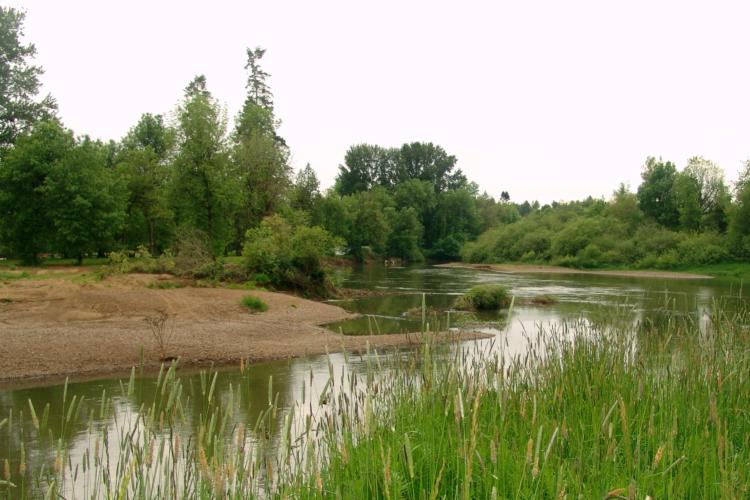
Special Fourth of July Ferry Over The Pudding River
Swimmers had a unique ride on July 4, 1932 at a swim park called Shade E Acres Amusement Park located in Canby, Oregon. The family amusement park was owned and operated by C.W. West. The car was an American Bantam and the cables stretched 120 feet across the river. The bottom cables provided the roadbed and the top cable increased the stability with the pulley. Back when the old times were lit!

This is the area where the swim park and cable car crossing was located back in 1932.
The river has experienced some flooding over the years, altering the course and topography of the river.
.

C.W. "Dad" West was born in Wisconsin and moved to Portland in 1889. He worked in Vancouver, WA and Oregon City as both a driver and conductor of horse drawn trolleys and cable cars. After retiring, he purchased a farm in Tigard, OR and ran a dairy with his son. While running his dairy, he developed several patents with hand trucks and farm wagons. His ingenuity plus experience with cable cars would provide him with the ability to build the unique cable system across the Pudding River.
 |
In 1930, West became interested in a small automobile called the Baby Austin produced by the Austin Car Company. He soon became a salesman for a car and began promoting it throughout the Portland area. He gave public demonstrations of the car, (which he charged 50 cents per person), and the car proved his claims, going 53 miles on a gallon of gas while achieved a top speed of 37 mph. These were impressive feats for a car in 1930. In fact, West was so impressed, he would select the Austin for his cable car bridge he would design and build several years later. In 1932, West designed and built an aerial ferry that featured the "Baby Austin" as his transport vehicle which carried passengers over the Pudding River. The Austin was a great choice as it was a small car weighing only 1100 pounds. West removed all 4 tires and fitted the rear wheels with rubber strips which created sufficient traction on the cables. The car ran over the 2 suspended cables on its steel rims and the cables acted as a roadway over the water. The car made the 120 foot trip under its own power. The car had no turntable for a turnaround, it just went in reverse for the return trip. The Austin was powered by a 45 cubic inch, 4 cylinder, 14-horsepower engine and equipped with hydraulic brakes. 2 American flags adorned the front bumper. West claimed the car could make 1,500 trips over the river on one gallon of gas. Riders were charged 10 cents a piece. The cable car was a novelty and was featured in both Popular Science Magazine and Popular Mechanics in 1932.  |
For his cable car ferry, West used an overhead pulley system similar to those used with ferries like the one seen above. He installed a cradle on the car with 4 points of attachment at each corner. This allowed the car to hang down enough so the wheels would ride on the suspended cables.

Often times, the riders in the car would stop and jump into the river.

The Shade E Acres water park featured 2 slides and a bathhouse.
In 1935, the Shade E Acres Amusement Park was sold and the name was changed to Pat's Acres. While the overhead cables that formed the bridge remained, the car was removed. Sometime in the 1950's, the cables were removed. Pat's acres expanded by adding diving boards, a rope swing, picnic tables, a baseball diamond and a concession stand. Later, a 5 room log home was constructed along with 4 cabins and a small store for visitors. A 40 x 60 foot dance hall was built that featured live music and dancing on the weekends. Overnight/seasonal camping, boating and fishing were also offered.
In 1956, the park was purchased by a group of businessmen who converted the park to a non-profit facility under the St Ignatius Parish. It remained open as a picnic ground for softball tournaments with the proceeds going to charity.
In 1965, the park was changed to a motorcycle race track. Races were held on Sundays and spectators were charged $1 for admission.
In 1972, motorcycle racing was phased out and go-cart racing was started.
By 1995, the park had expanded to 44 acres in size and featured a paved 1/2 mile track with 6 turns and a 600 foot straight away. Serious kart racers loved it.
Today, the park is known as Pat's Acres Racing Complex.

Comments
Post a Comment